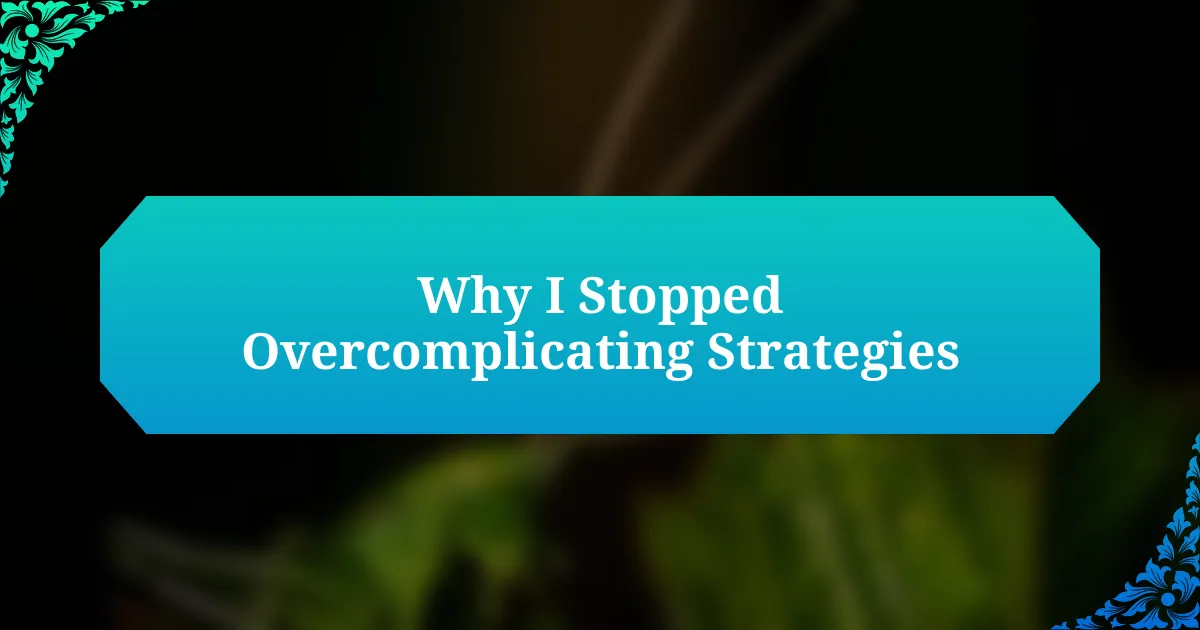Key takeaways:
- Effective partnerships in cricket stem from strong communication and mutual trust, allowing players to elevate each other’s performance under pressure.
- Adapting strategies in response to match dynamics is crucial, enabling players to maintain composure and optimize their approach to succeed.
- Emotional support and a positive mindset can significantly impact performance, helping players navigate challenging situations collaboratively.
- Patience is essential during tense moments, allowing teams to assess situations carefully and make strategic decisions for success.
Author: Emily Thornton
Bio: Emily Thornton is an award-winning author known for her compelling storytelling and richly developed characters. With a background in literature and a passion for exploring the complexities of human relationships, she has penned several best-selling novels that resonate with readers around the globe. Emily’s work has been featured in prominent literary journals, and she is a regular contributor to various writing workshops. When she’s not writing, Emily enjoys hiking in the beautiful landscapes of her hometown and spending time with her rescue dogs. She currently resides in Portland, Oregon, where she continues to create captivating narratives that inspire and entertain.
Understanding cricket partnerships
In cricket, partnerships are the lifeblood of a successful innings. I remember watching a thrilling match when two lower-order batsmen, who barely knew each other, came together and built a crucial partnership. Their chemistry grew with every run, demonstrating how two players can elevate each other’s performance, creating an undeniable synergy on the field.
Have you ever noticed how the best teams often have batsmen who create unbreakable bonds in tough situations? I vividly recall a match where two players, under immense pressure, shared smiles and nods, communicating without words. That unspoken understanding can turn fear into focus and help players navigate challenging overs together.
Understanding cricket partnerships extends beyond just runs scored; it’s about strategy and support. When one player takes risks, the other can play a stabilizing role. I once saw a seasoned opener guide a young debutant through a tense chase, offering advice and encouragement. This balance not only builds confidence but can also demystify the pressure cooker of international cricket.
Importance of teamwork in cricket
Teamwork in cricket is more than just playing alongside each other; it’s about building trust and making strategic decisions together. I recall a tense situation when I was playing in a local league, surrounded by friends. As we faced a formidable bowling attack, my batting partner and I leaned on each other’s strengths, encouraging one another to settle into the match, turning pressure into a collective effort. This kind of camaraderie is vital, as each player’s unique abilities can complement the other, leading to better performance overall.
What truly struck me in those moments was how communication between teammates can transform the game. I’ve seen situations where a simple gesture or a reassuring word can elevate a player’s confidence. Watching two seasoned players share insights almost instinctively on what the bowler might do next opened my eyes. It’s refreshing to think about how even the most challenging overs can feel conquerable when players trust one another to stay alert and engaged.
At its core, teamwork fosters resilience. During one memorable match, we lost a couple of early wickets and the atmosphere was tense. However, my batting partner and I decided to focus on striking a balance between aggression and caution, rallying each other with each successful run. This experience taught me that teamwork is often about lifting up one another, pushing through adversity, and finding a way back to success together. It reflects the essence of cricket—a game where every player’s contribution matters, and united efforts can lead to remarkable outcomes.
Strategies for effective partnerships
Establishing a solid understanding with your batting partner is key to forming effective partnerships on the field. I remember a specific match where my partner and I agreed on a plan before facing the opposition’s best bowler. We decided to rotate singles and wait for the loose ball, which gave us the confidence to build a solid foundation during a pressure situation. Have you ever felt that ease when you’re both on the same wavelength? It’s liberating, and it opens up a world of possibilities.
Another significant strategy I discovered is the importance of adapting to the game’s dynamics together. During a tournament, my partner and I faced bowlers who were surprisingly difficult to read. While I wanted to take a few risks, my partner wisely reminded me to be patient. We adjusted our approach, capitalizing on their errors instead of forcing the game. This fluidity in our partnership not only kept the scoreboard ticking but also helped us maintain our composure. Isn’t it fascinating how adaptability can turn a seemingly insurmountable challenge into an achievable goal?
Moreover, supporting each other’s mental state can sometimes be even more critical than the technical aspects of batting. I was once in a dire scenario where my partner was visibly shaken after a close call. Instead of just offering advice, I focused on bolstering his spirits with light-hearted banter, reminding him that we were in this together. I’ve found that even simple acts of encouragement can ignite a spark of confidence, allowing a player to regain focus and perform at their best. How often do we underestimate the power of a few kind words?
Communication techniques during play
Effective communication on the field isn’t just about words; it’s also about understanding non-verbal cues. I recall a match where my partner and I developed a knack for subtle gestures. A simple nod or raising a finger could signal a quick single or a halt. This fluidity in communication reduced the risk of misjudgments, allowing us to focus solely on the game. Have you ever found yourself in a situation where a glance said more than a thousand words?
Another technique that has worked wonders is using a consistent code language to convey strategies mid-play. For instance, we used animal names to signify aggression or caution; ‘lion’ meant go for the boundary, while ‘tortoise’ called for patience. This playful approach not only made communication easier but also kept the atmosphere light. Have you ever considered how a distraction can sharpen your focus instead of pulling you away from it?
I’ve also learned that honesty is key, especially during tense moments in the game. There was a time when my batting partner hesitated after a few poor deliveries. I knew he needed reassurance, so I openly shared my thoughts, letting him know it was okay to be cautious. This honesty cultivated a deeper trust between us and helped him regain his confidence. How often do we truly voice our feelings on the pitch, knowing it can change everything?
Adapting to different match situations
Adapting to different match situations requires a keen awareness of the game’s dynamics. I remember a particular match where the opposition bowler was on a roll, and we had to reassess our strategy quickly. My partner and I huddled together for a brief chat during a timeout—this wasn’t just to discuss shots but to refocus our mental game. It’s fascinating how a simple strategy shift can turn the tides; have you ever felt that sudden clarity when you just needed to adapt?
On another occasion, we found ourselves chasing a challenging total with limited overs left. Instead of sticking to our usual play style, we decided to shift gears and play more aggressively without losing our heads. I recall hitting a few aggressive boundaries, which not only boosted our score but also put pressure on the opposition. It’s moments like these that showcase the importance of flexibility; can you think of a time when you had to pivot quickly, and how did that affect your game?
The emotional aspect of adapting can’t be overlooked either. There was a scenario where we were 50 runs behind, and the mood in the dressing room was tense. I took it upon myself to lighten the atmosphere, reminding my partner that this was just a part of the game and we could turn it around. That moment of levity made a huge difference, allowing us to recalibrate and approach the chase with fresh enthusiasm. How can a change in mindset during critical moments help shift the momentum in your favor?
Personal lessons from partnerships
When it comes to partnerships, one of the key lessons I’ve learned is the value of communication. I vividly remember a pivotal game where my partner and I were both facing a challenging spell of bowling. We used subtle nods and gestures to signal our plans, avoiding unnecessary chatter that could disrupt our focus. Have you experienced a moment when non-verbal cues made all the difference? It’s amazing how a shared understanding can often speak louder than words.
Another crucial insight I gained is the importance of mutual trust. There was a match where I played a risky shot, fully aware that my partner would back me up if things went south. As I connected with the ball and it sailed over the boundary, I felt that thrill of teamwork. It made me realize how our confidence in each other allowed us to take calculated risks and elevate our game. Have you ever felt empowered by your teammate’s belief in you?
Lastly, I’ve come to appreciate the power of patience in partnerships. During a particularly tense chase, there was a moment when we both felt the pressure to score quickly. Instead of panicking, we decided to bide our time and assess the situation, slowly building the partnership. I recall feeling a wave of relief when we recalibrated our strategy, ultimately leading to a successful finish. What does patience look like in your game, and how has it helped you navigate high-pressure situations?
Applying insights in future games
When applying these insights to future games, I’ve realized that effective communication can transform how we approach our game strategy. I recall a match where we entered with a pre-planned signal system, which helped us seamlessly navigate tricky overs. Have you ever found yourself in a scenario where quick signals completely changed the tide of a game? That day, it taught me that preparation combined with in-game adjustments can create a solid foundation for success.
Trust is another cornerstone that I plan to carry forward. There was an instance when I needed to read the game at a critical juncture, and my partner’s unwavering belief in my decision to play aggressively allowed us to seize an opportunity, ultimately tilting the match in our favor. How often do you let trust guide your decisions on the field? This has led me to prioritize building rapport with my teammates so that we can collectively navigate challenges and embrace risks together.
Lastly, patience has revealed itself to be a powerful ally on the field. I remember a game where we intentionally slowed our run rate to assess our opponents’ weaknesses rather than succumbing to external pressure. It was in that moment of composure that we discovered openings that led us to victory. Have you taken the time to think strategically in the heat of the moment? Embracing patience can allow us to make better decisions and create more opportunities, ultimately unlocking our full potential as a team.





